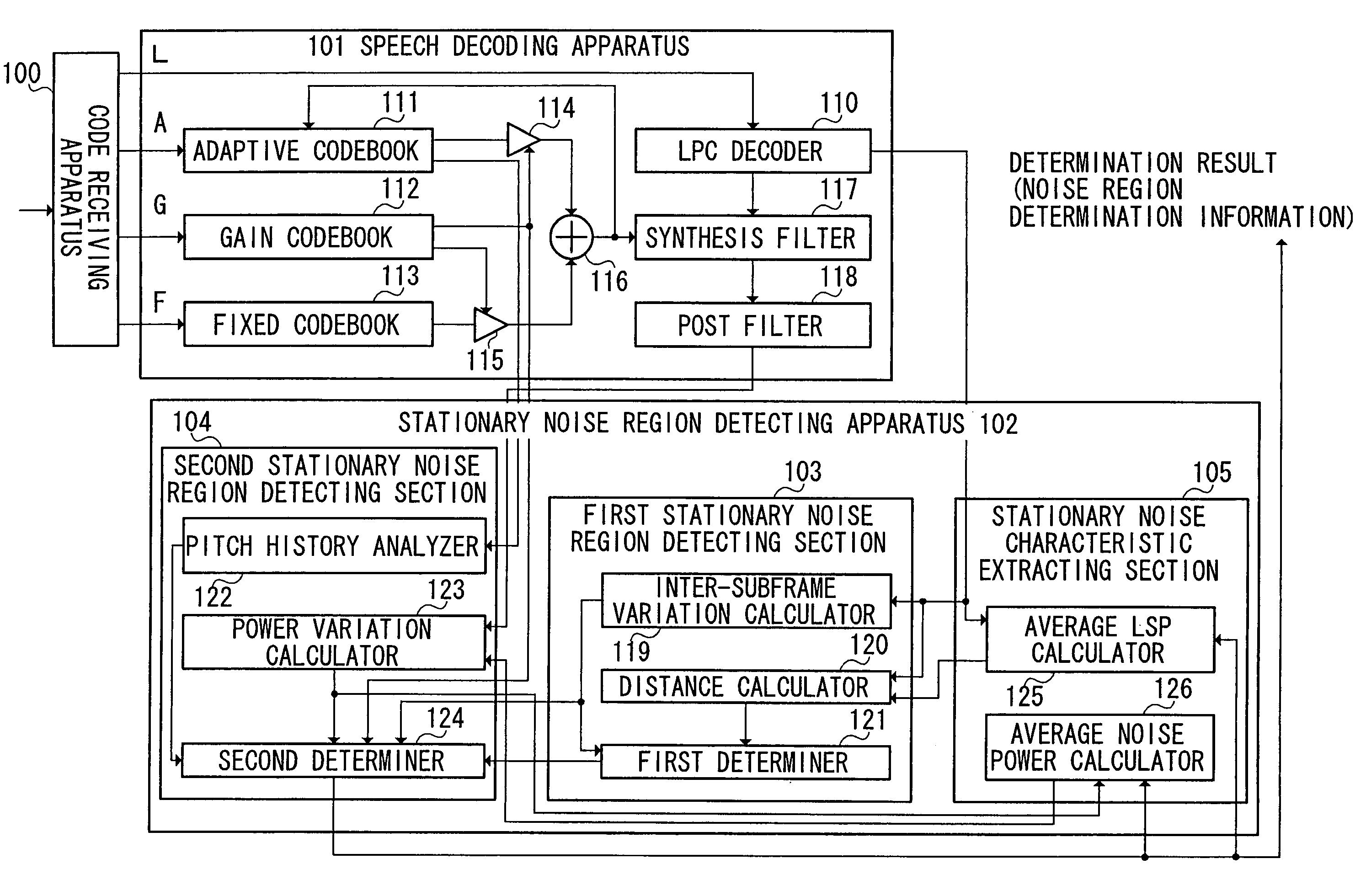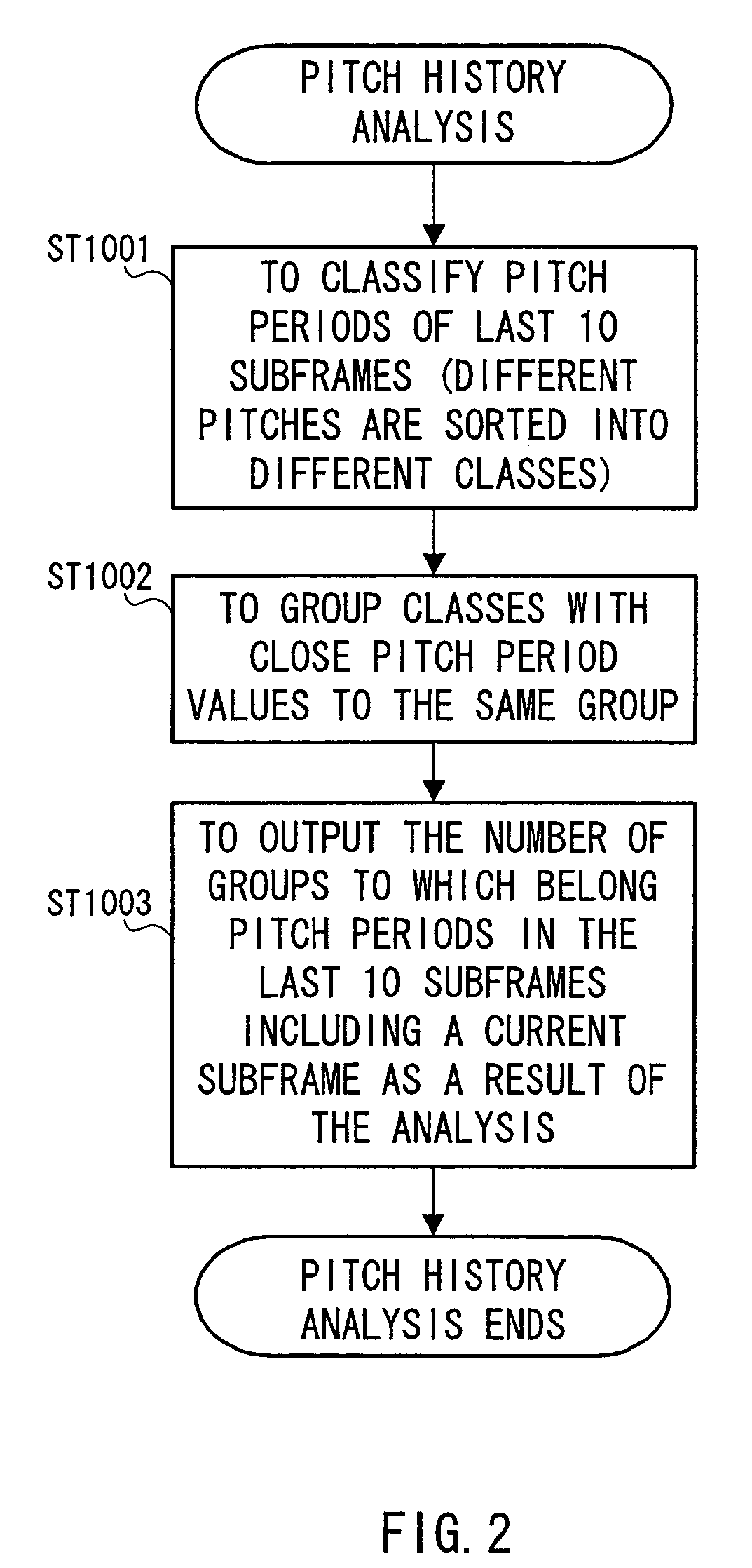Speech decoder that detects stationary noise signal regions
- Summary
- Abstract
- Description
- Claims
- Application Information
AI Technical Summary
Benefits of technology
Problems solved by technology
Method used
Image
Examples
first embodiment
[0022]FIG. 1 illustrates a configuration of a stationary noise period identifying apparatus according to the first embodiment of the present invention.
[0023]Given a digital signal input, an encoder (not shown) first performs an analysis and quantization of Linear Prediction Coefficients (LPC), pitch search, fixed codebook search and gain codebook search, and then transmits the LPC code (L), pitch period (A), fixed codebook index (F) and gain codebook index (G).
[0024]A code receiving apparatus 100 receives the encoded signal transmitted from the encoder, and separates the code L representing the LPC, a code A representing an adaptive code vector, code G representing gain information and code F representing a fixed code vector, from the received encoded signal. The code L, code A, code G and code F are output to a speech decoding apparatus 101. TO be more specific, the code L is output to an LPC decoder 110, code A is output to an adaptive codebook 111, code G is output to a gain code...
second embodiment
[0088]FIG. 5 illustrates the configuration of a stationary noise post-processing apparatus according to the second embodiment of the present invention. In FIG. 5, the same parts as in FIG. 1 are assigned the same reference numerals as in FIG. 1, and specific descriptions thereof are omitted.
[0089]A stationary noise post-processing apparatus 200 is comprised of a noise generator 201, adder 202 and scaling section 203. In stationary noise post-processing apparatus 200, adder 202 adds a pseudo stationary noise signal generated in noise generator 201 and the post-filter output signal from speech decoding apparatus 101, scaling section 203 adjusts the power of the post-filter output signal after the addition by performing scaling processing, and the resulting post-filter output signal becomes outputs of stationary noise post-processing apparatus 200.
[0090]Noise generator 201 is comprised of an excitation generator 210, synthesis filter 211, LSP / LPC converter 212, multiplier 213, multipli...
third embodiment
[0105]FIG. 6 illustrates a configuration of a stationary noise post-processing apparatus according to the third embodiment of the present invention. In FIG. 6, the same parts as in FIG. 5 are assigned the same reference numerals as in FIG. 5, and specific descriptions thereof are omitted.
[0106]In addition to the configuration of stationary noise post-processing apparatus 200 shown in FIG. 2, the apparatus in this embodiment further comprises memories for storing parameters required in noise signal generation and scaling upon frame erasure, a frame erasure concealment processing controller for controlling the memories, and switches used in frame erasure concealment processing.
[0107]A stationary noise post-processing apparatus 300 is comprised of a noise generator 301, adder 202, scaling section 303 and frame loss compensation processing controller 304.
[0108]Noise generator 301 has a configuration that adds to the configuration of noise generator 201 shown in FIG. 5, memories 310 and ...
PUM
 Login to View More
Login to View More Abstract
Description
Claims
Application Information
 Login to View More
Login to View More - R&D
- Intellectual Property
- Life Sciences
- Materials
- Tech Scout
- Unparalleled Data Quality
- Higher Quality Content
- 60% Fewer Hallucinations
Browse by: Latest US Patents, China's latest patents, Technical Efficacy Thesaurus, Application Domain, Technology Topic, Popular Technical Reports.
© 2025 PatSnap. All rights reserved.Legal|Privacy policy|Modern Slavery Act Transparency Statement|Sitemap|About US| Contact US: help@patsnap.com



